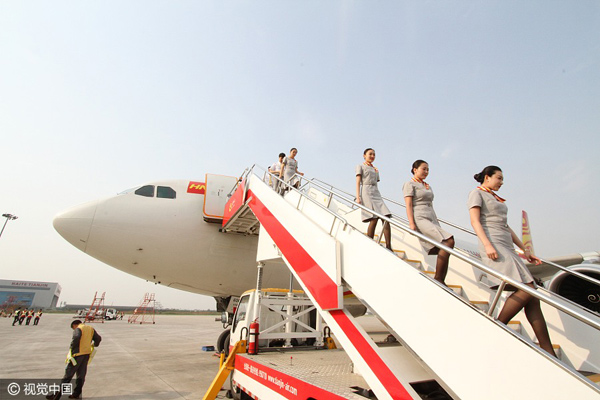A world-class airport cluster is set to take off
 |
|
An A330 aircraft lands at Tianjin Binhai International Airport, May 5, 2016. [Photo/VCG] |
Beijing will serve international flights, Hebei low-cost airlines and Tianjin freight operations
Shijiazhuang Zhengding International Airport, in the capital's neighboring Hebei province, has seen a 50 percent year-on-year increase of passengers from Beijing during the three-day Qingming holiday.
"About 1,500 passengers from Beijing took off from Hebei this holiday," said Cheng Shanshan, an airport spokesperson.
Some domestic airlines, especially those serving Beijing Capital International Airport's 28 percent of airlines to and from second- and third-tier cities, will be transferred to the airport and neighboring Tianjin Binhai International Airport, Feng Zhenglin, head of the Civil Aviation Administration of China, said earlier.
The two airports will form a world-class cluster which is being established in the Beijing-Tianjin-Hebei region to promote integrated development, according to a guideline for the coordinated development of civil aviation in the region released at the end of last year.
According to the guideline, the airport in Tianjin will develop into an international center for freight, while the airport in Hebei will mainly serve popular low-cost airlines.
Beijing will mainly serve international airlines when the capital's second-largest airport is completed in 2019, said China's top civil aviation official.
"Beijing will be built into an international aviation hub while its current domestic flights will be transferred to two neighboring areas-Tianjin municipality and Hebei province," Feng said.
Airports in the cluster will be connected by intercity high-speed railways and urban rail, Feng said.
According to Feng, Beijing's two existing airports have reached their capacity ceiling.
"During peak hours, Beijing Capital International Airport has to handle a plane taking off or landing every 49 seconds on average," Feng said.
The capital has started building a new civilian airport-Daxing International Airport-in an area overlapping the Daxing district in Beijing and Langfang in Hebei.
When completed in 2019, the airport will mainly serve international airlines, together with the capital's existing airports.
Feng cited one example to highlight the region's future airspace integration and comprehensive transportation connectivity.
"Passengers landing in Tianjin can consider they have landed in Beijing, because in the future a high-speed train will connect Beijing Capital International Airport and Tianjin Binhai International Airport," Feng said.
















